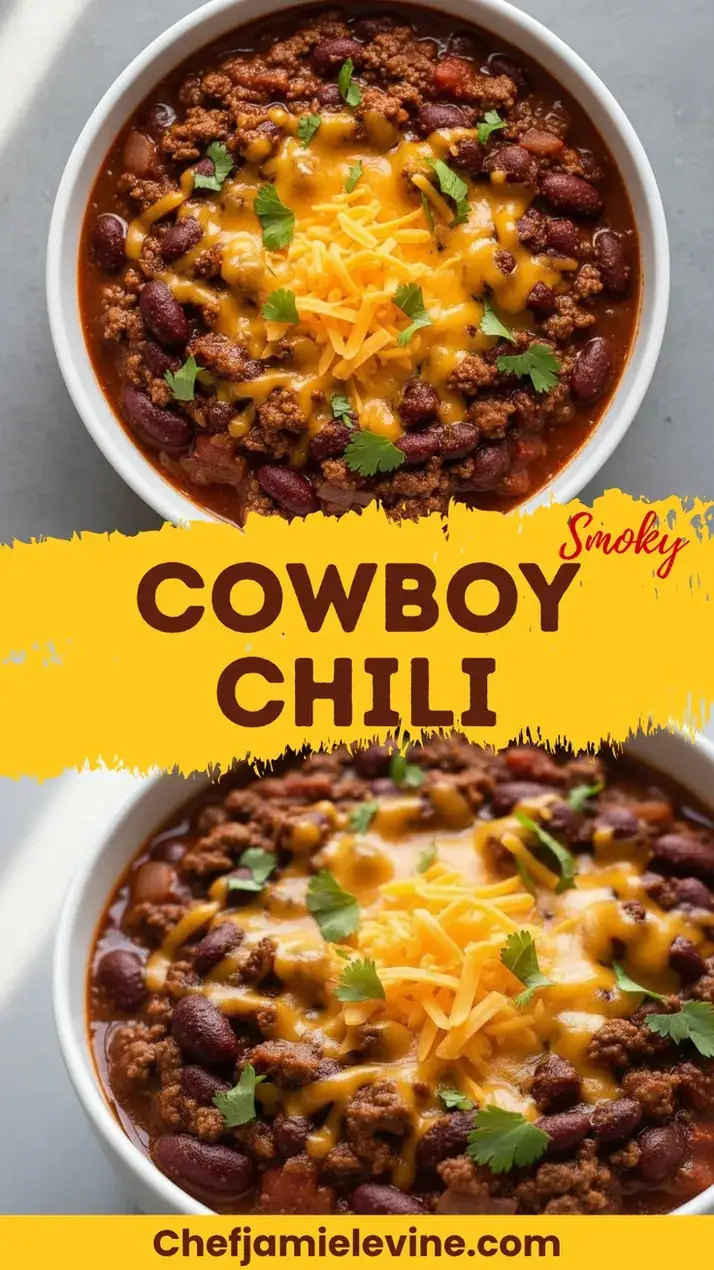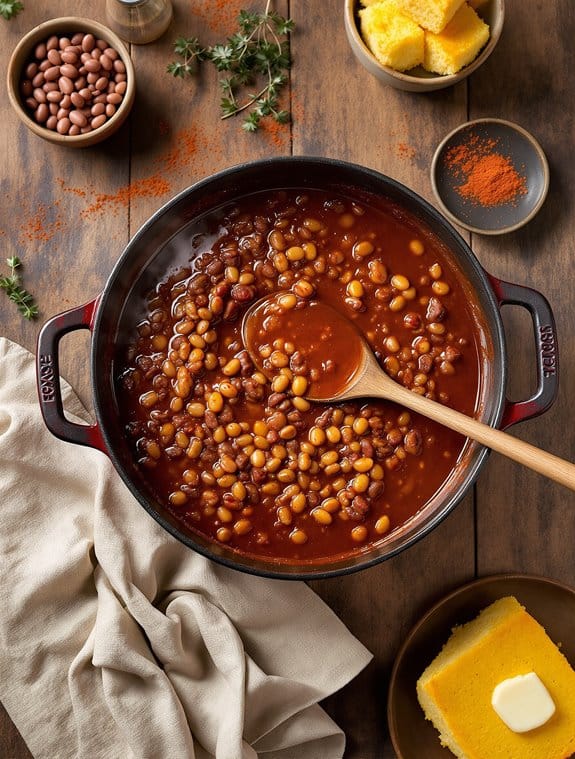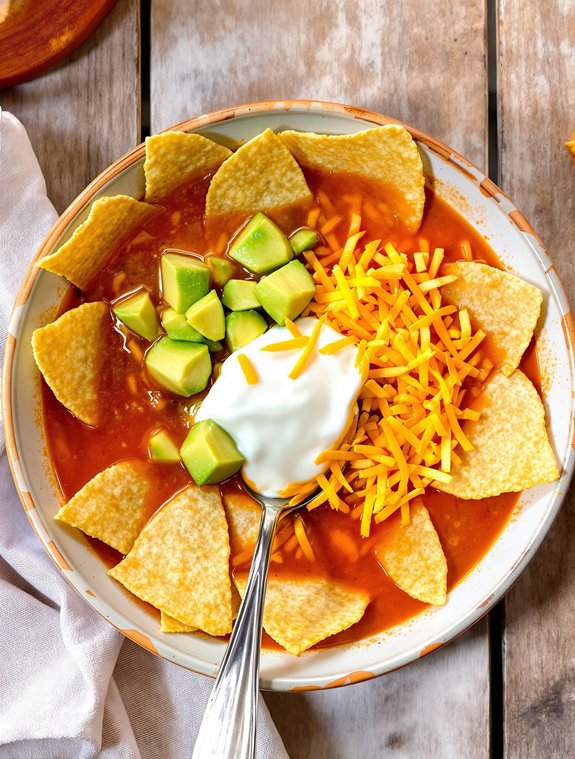Why You’ll Love this Authentic Cowboy Chili
If you’ve ever wanted to taste the rugged spirit of the Old West in a bowl, this authentic cowboy chili is your ticket to culinary time travel. I adore how it combines simplicity with deep, complex flavors—just like the cowboys needed after a long day on the range.
What makes it special? The perfect balance of lean beef, aromatic spices, and those hearty pinto beans.
And can we talk about that hour-long simmer? That’s where the magic happens. The flavors meld and intensify, creating something truly soul-warming.
Even better, it tastes more amazing the next day. Make-ahead comfort food? Yes, please.
What Ingredients are in Authentic Cowboy Chili?
When it comes to authentic cowboy chili, we’re talking about simple, hearty ingredients that could withstand the rigors of trail life. This isn’t your fancy competition chili with secret ingredients—it’s straightforward, robust fare designed to fuel hard-working cowboys after long days in the saddle.
The beauty of this recipe lies in its accessibility; most of these ingredients are pantry staples that come together to create something truly special.
- 3/4 pound extra lean ground beef
- 2 cloves garlic, minced
- 1 medium yellow onion, chopped
- 1 (15 ounce) can chopped stewed tomatoes
- 1 cup beef broth
- 2 tablespoons chili powder
- 1 teaspoon ground cumin
- 1 teaspoon dried oregano
- 1/8 teaspoon cayenne pepper
- 1 (15 ounce) can pinto beans, drained
- 1/2 teaspoon salt
While the ingredient list is straightforward, there are several factors worth noting. The choice of extra lean ground beef reflects modern health consciousness, though traditional cowboys would have used whatever meat was available—often tougher cuts that benefited from long simmering.
The spice level is moderate, with just 1/8 teaspoon of cayenne, making this family-friendly while still offering that signature warmth. And yes, this recipe does include beans, which might spark debate among chili purists, but the pinto beans add wonderful texture and heartiness that makes this a complete one-pot meal.
Feel free to adjust the spice levels to your preference—the cowboys certainly would have.
How to Make this Authentic Cowboy Chili

Making authentic cowboy chili is wonderfully straightforward, just the way the trail cooks would have wanted it. Start by grabbing a large saucepan and cooking 3/4 pound of extra lean ground beef along with 2 cloves of minced garlic and 1 medium chopped yellow onion over medium heat.
You’ll want to stir this mixture until the beef is completely browned, which takes about 10 minutes. This initial browning process is essential—it builds the flavor foundation for your entire chili. Once browned, don’t skip the draining step; removing excess fat gives you a cleaner-tasting final product.
Next comes the heart of the chili. Stir in one 15-ounce can of chopped stewed tomatoes (with their liquid), 1 cup of beef broth, 2 tablespoons of chili powder, 1 teaspoon of ground cumin, 1 teaspoon of dried oregano, and 1/8 teaspoon of cayenne pepper.
This spice blend gives the chili its signature warmth without overwhelming heat. Reduce the heat to low, cover the pot, and let it simmer, stirring occasionally, for a full hour. This long, slow cooking process is where the magic happens—the flavors meld together, the meat becomes tender, and the sauce thickens to that perfect chili consistency. Can you smell it already? I can almost sense that rich aroma filling the kitchen.
For the final stretch, add one 15-ounce can of drained pinto beans and 1/2 teaspoon of salt. Continue cooking and stirring for another 15 minutes to integrate the beans fully into the mixture.
Here’s a cowboy-approved tip: this chili actually tastes better the next day after the flavors have had time to fully develop. If you’re planning ahead, refrigerate your chili after cooking and simply reheat it over low heat when you’re ready to serve.
The cowboys might’ve enjoyed this beside a campfire, but your dining table will work just fine for this hearty, satisfying meal.
Authentic Cowboy Chili Substitutions and Variations
Many cowboys on the trail had to make do with what was available, which is why authentic cowboy chili has always been adaptable at its core.
I often swap ground turkey for beef when I’m watching calories, and it still delivers that hearty satisfaction. No pinto beans? Black or kidney beans work beautifully.
Vegetarians can use textured vegetable protein or extra beans instead of meat. For heat lovers, add more cayenne or toss in fresh jalapeños.
Sometimes I’ll throw in a can of corn or bell peppers for extra texture. My secret twist? A splash of coffee or dark beer adds incredible depth.
Isn’t experimentation what cooking’s all about?
What to Serve with Authentic Cowboy Chili
No traditional cowboy chili experience is complete without the perfect sides to round out your meal.
I always serve mine with a stack of warm cornbread, slightly sweet and crumbly, perfect for sopping up those last bits of spicy sauce. A simple green salad with ranch dressing provides a cool counterpoint to the heat, while a dollop of sour cream on top of each bowl melts beautifully into the chili.
For the full experience, try offering bowls of diced onions, shredded cheddar, and sliced jalapeños so everyone can customize their own bowl, just like I learned on my grandfather’s ranch.
Final Thoughts
Whether you’re gathering around a campfire under the stars or serving up comfort food on a chilly winter evening, this authentic cowboy chili recipe connects us to America’s rugged culinary heritage.
I’ve found that the true magic happens when you give this chili time to develop—those beans soaking up all that spicy goodness, the beef becoming tender, the flavors melding into something greater than their parts. Some days, I make it just to fill my home with that irresistible aroma. Isn’t that sometimes the best part of cooking?

Cowboy Chili
Ingredients
Equipment
Method
- In a large saucepan over medium heat, cook the ground beef, minced garlic, and chopped onion, stirring frequently until the beef is completely browned (about 10 minutes).
- Drain any excess fat from the pan.
- Add the stewed tomatoes with their liquid, beef broth, chili powder, cumin, oregano, and cayenne pepper to the pan. Stir to combine.
- Reduce heat to low, cover the pot, and simmer for 1 hour, stirring occasionally to prevent sticking.
- Add the drained pinto beans and salt. Continue cooking and stirring for another 15 minutes to fully incorporate the beans.
- Taste and adjust seasonings if necessary before serving.



